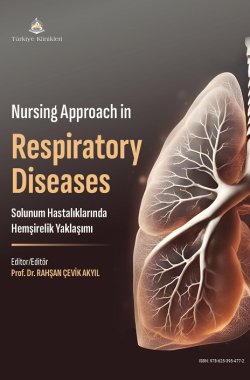The Importance of Health Literacy in Preventing Respiratory Diseases
Fisun ŞENUZUN AYKARa , Gökşen POLATb
aİzmir Tınaztepe University Faculty of Health Sciences, Department of Nursing, Division of Internal Medicine Nursing, İzmir, Türkiye
bİzmir Tınaztepe University Vocational School of Health Services, Department of Nursing, Department of Internal Medicine Nursing, İzmir, Türkiye
Şenuzun Aykar F, Polat G. The importance of health literacy in preventing respiratory diseases. In: Çevik Akyıl R, ed. Nursing Approach in Respiratory Diseases. 1st ed. Ankara: Türkiye Klinikleri; 2025. p.104-8.
ABSTRACT
Health literacy; it is defined as reaching the level of personal knowledge and skills activated to improve individual and social health by changing the individual’s lifestyle. While the starting point of the concept is infectious diseases, its importance in non-communicable diseases has been understood from the recent past to the present and studies have been included in these areas. With the COVID-19 pandemic, there has been a return to infectious diseases. Both infectious and non-communicable diseases should be considered together in the prevention and control of respiratory system diseases. When risk factors and precautions are examined, they include similar basic health behaviours and consist of principles that should be applied for a healthy life. These behaviours; An active life, avoiding insurance and alcohol consumption, and healthy nutrition can be given as examples. As with all chronic diseases after disease development, individuals’ ability to self-manage respiratory system diseases is related to improved health literacy. In this section, all respiratory system diseases, communicable and non-communicable, are discussed and health literacy initiatives in disease prevention and control are included.
Keywords: Health literacy; respiratory system diseases; nursing
Kaynak Göster
Referanslar
- Kickbusch I, Pelikan JM, apfel F, tsouros aD. Health literacy the solid facts. World Health Organization; 2013.
- Ozdemir S, akca H. Health literacy in turkey. Med J SDU. 2021;28(3):535-6. [Crossref]
- Oztas D, Guzeldemirci G, Ozhasanekler a, yıldızbası e, Karahan S, Karataş eray İ, et al. evaluation of emergency department applications from the perspective of health literacy. ankara Med J. 2016;(3):255-62.
- Berkman ND, Sheridan Sl, Donahue Ke, Halpern DJ, Viera a, crotty K, et al. Health literacy interventions and outcomes: an updated systematic review. evid rep technol assess (Full rep). 2011;(199):1-941.
- Gozlu Ka. a social determinant of health: Health literacy. Med J SDU. 2020;27(1):137-44. [Crossref]
- Soykan H, Sengul H. the relationship between health literacy and healthy lifestyle behaviours. GÜSbD. 2021;10(4):691-704. [Crossref]
- Sanlıturk D. Investigation of the relationship between health literacy and disease control in asthma patients. Hacettepe University Journal of Nursing Faculty.2022;9(3):291-9.
- Dogan M, cetinkaya F. the relationship between health literacy level and positive health behaviours in academicians. Journal of Health Sciences. 2019;28(3):135-41. [Crossref]
- Ozturk ID. the use of public service announcements in health communication: reading anti-smoking public service announcements with cultural indicators. Gaziantep University Journal of Social Sciences. 2020;19(1):170-89. [Crossref]
- Erdogan r, cil b, Murat H, yılmaz GK. examination of informative videos published by the Ministry of Health about covid-19 vaccine with eye tracking technique. Mehmet akif ersoy University Journal of applied Sciences. 2022; 6(1):165-83. [Crossref]
- Tengilimoglu D, Guzel a, Gunaydın e. Smoke-free airspace within the scope of social marketing: a sample application. Gazi University Journal of Faculty of economics and administrative Sciences. 2014;15(2):1-26.
- Ministry of National education General Directorate of Support Services circular on foods to be sold in school canteens and inspection of food establishments in educational institutions in terms of hygiene. 2020. [cited: 27.01.2024]. available from: [Link]
- Ozkan S, tuzun H, Dikmen aU, İlhan MN. community behaviour and health literacy in epidemics. J biotechnol and Strategic Health res. 2020;1(Special Issue):105-10.
- Shikha D, Kushwaha P, Gokdemir O, Marzo rr, bhattacharya S. editorial: Health literacy and disease prevention. Front Public Health. 2023;11:1128257. [Crossref] [PubMed] [PMC]
- cınar b, Gungor y, Uyar S, tarhan Ç. the impact of cOVID-19 pandemic on digital transformation processes in turkey. Journal of research in business. 2022;7(19):91-102. [Crossref]
- Poureslami I, Shum J, Kopec J, Sawatzky r, Gupta S, Pakhale S, Ket al; canadian airways Health literacy Study Group. Development and Pretesting of a New Functional-based Health literacy Measurement tool for chronic Obstructive Pulmonary Disease (cOPD) and asthma Management. Int J chron Obstruct Pulmon Dis. 2020;15:613-25. [Crossref] [PubMed] [PMC]
- Jeganathan c, Hosseinzadeh H. the role of health literacy on the self-management of chronic obstructive pulmonary disease: a systematic review. Journal of chronic Obstructive Pulmonary Disease. 2020;17(3):318-25. [Crossref] [PubMed]
- Puente-Maestu l, calle M, rodríguez-Hermosa Jl, campuzano a, de Miguel Díez J, Álvarez-Sala Jl, et al. Health literacy and health outcomes in chronic obstructive pulmonary disease. respiratory Medicine. 2016;115:78-82. [Crossref] [PubMed]
- Kaya e, Karaca Sivrikaya S. Health literacy and nursing. Sted. 2019;28(3): 216-21.
- Ekinci y, tutgun Una a, tarhan N. a literature review on digital health literacy. bayterek International Journal of academic research. 2021;4(2):148-65. [Crossref]
- Cekic S, Karali Z, canitez y, esmen S, Ortac H, abdu S.the effects of health literacy on disease control in adolescents with asthma, Journal of asthma. 2023;60(8):1566-72. [Crossref] [PubMed]
- Kozak F, Çevik akyıl r. the relationship between health literacy and quality of life in elderly individuals. Journal of Nursing Science. 2021;4(3):122-32.

